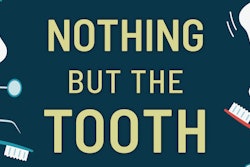
"I had no idea my patient was unhappy."
Dentists are often surprised to discover a disgruntled patient. A patient may appear satisfied when he or she leaves the office, but once at home, a spouse or friend might say, "Why is that tooth shorter than the one next to it?" or "The color doesn't match." Most humans are conflict-averse and may not return to present a complaint. Some patients will go to a subsequent provider who may exacerbate the situation by agreeing that the color doesn't match. Others may comment online or complain to their friends. Research has shown that negative comments are shared much more frequently than positive ones. Still others will fume silently.
Important points to remember
Be proactive by keeping the lines of communication open. Check on the patient afterward to see how he or she is doing, particularly in aesthetic cases. Invite the patient to come in and discuss any issues.
If someone does complain, don't ignore the issue. Provide explicit instructions to your front desk staff to give you all messages, good and bad. Speak to the patient directly rather than hiding behind your office manager. At the first sign of a significant problem, inform your liability carrier. The insurance company has experience in this area and may provide useful input.
 Dr. Teresa Yang.
Dr. Teresa Yang.Check your records and the statute of limitations in your state. In California, the statute begins one year from the date of the patient's discovery of the problem and three years from the date of treatment. This does not apply to minors whose statutes don't begin until adulthood. Use your judgement, though. If the bridge you placed failed in three years and one month, is it worth the risk to ignore the patient's complaint? There is no statute of limitations on social media.
Reestablish the relationship with the patient. A face-to-face discussion is ideal. If the patient consents to a meeting, choose a safe environment and time. Rather than meeting in the operatory, select a setting such as the reception area where you and the patient have equal status. Pick a time when no other patients are present and interruptions are unlikely. Set boundaries as needed. For instance, what will you do if the patient uses obscenities or becomes physically threatening?
Most patients simply want to be heard, so practice active listening. Ask open-ended questions: "What caused you to change your mind?" or "How can we reach a solution together?" Stay away from "why" questions, as these may be interpreted as accusatory. Instead of planning your response, really listen (without interruption) to the patient. Observe your and the patient's body language. Are you fidgeting or looking at the clock? Does the patient appear frustrated? Research has shown that most communication is nonverbal and transmitted via tone of voice and body language, rather than actual words.
Once the patient has finished, acknowledge and restate the complaint: "Let me understand what you just said ... is that about right?" Speak slowly and evenly, slower than you normally would, and control your tone of voice. Use empathy in your approach. Empathy is your ability to understand the patient's point of view even if you don't agree with it.
Keep the people and the problem separate, and focus your comments strictly on the problem. Acknowledge the patient's emotions. For example, in the situation where a deep filling has resulted in an irreversible pulpitis and now the patient needs a root canal and crown, you might say, "It seems that you are anxious and worried about how you'll be able to afford this large unanticipated expense." Keep your own emotions in check, though. If the patient attacks you personally, do not reciprocate.
After you've summarized the patient's complaint, be quiet and give the patient an opportunity to respond. The goal is to let the patient reveal what it will take to resolve the conflict. If the patient says, "Doc, there's nothing you can do to fix the problem," try not to hear this as a sign of rejection. The patient wouldn't be meeting with you if he or she actually thought that. Use this "no" as a starting point to explore options together.
So, what are the options?
The patient may want you to redo dental work. Others will have lost confidence and prefer another dentist treat them -- and send you the bill.
Some states have peer-review programs within organized dentistry. Some insurance carriers have patient grievance protocols. The state board may also review complaints, but it is often a time-consuming process with few concrete recommendations. In California, the state board will not mandate refunds. It will, however, refer egregious violations to the attorney general.
Small claims court is another option where the damages will be contained. However, your work will not be evaluated clinically, and the judge will likely have no dental knowledge. A lawsuit is certainly an option, but one to be avoided as it is slow, costly, intrusive, uncertain, and very stressful. A neutral mediator may be an attractive option. This strategy has seen a marked increase in popularity across all industries and types of disputes during the COVID-19 crisis, as courts are bottlenecked or closed.
Finally, whether the complaint has grounds or not, consider writing the patient a check. Remove your ego or your desire to validate the dental treatment and consider the stress you will undergo in the process of resolving the complaint. Maybe writing the patient a check and saying goodbye to the problem is the best solution.
Before you issue the check, though, secure a written, signed release from the patient that also includes removal of any comments from social media and a promise not to post in the future. Your liability carrier may have samples of such documents.
And remember, the best way to manage a patient conflict is to prevent it in the first place.
Dr. Teresa Yang started two practices from scratch and sold them both. She currently serves as a trustee at the California Dental Association (CDA) and is a member of the CDA Foundation Board. She is also the editor of WestViews at the Western Los Angeles Dental Society. Her general interest articles have been published in online literary journals and on humor sites. She can be reached at [email protected].
The comments and observations expressed herein do not necessarily reflect the opinions of DrBicuspid.com, nor should they be construed as an endorsement or admonishment of any particular idea, vendor, or organization.



















